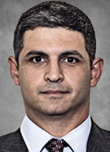Don't Blame The Molecule; You May Be The Problem

By Louis Garguilo, Chief Editor, Outsourced Pharma

Ali Pashazadeh has been a “healthcare investment banker for 20 years, practicing surgeon for 30 years, and biotech CEO.”
He’s founder, Chairman and CEO of Treehill Partners, a “strategic and financial advisory firm focused exclusively on healthcare.” Treehill recently added a service offering that optimizes drug development to lead to viable commercial outcomes – and involves both drug sponsors and service providers.
“I can explain our logic in two minutes,” Pashazadeh says at the outset of what became a much longer dialogue.
Investor’s Brief

“In the drug development arena, the biggest mistake biotechs start off making is they say, for example, ‘I have an exciting molecule, it will target age-related macular degeneration (AMD).’
The CROs and CDMOs reply, ‘That’s fantastic, this is how we’ll develop your molecule for you.’
No one at that starting point says, ‘Wait a minute, this molecule practically has no chance of succeeding in this indication. Have you thought about developing it for another indication, or targeting a completely different formulation?’
It’s basically the same with the FDA, which says ‘don’t harm patients,’ and after some investigation, simply waives you along to next steps.
So neither the FDA nor your external partner helps determine whether you're actually going to have a commercially-viable and profitable product.”
Treehill, says Pashazadeh, fills that gap. When a biopharma approaches the company looking for a development partner, they work together to obtain a commercial viability determination.”
That includes looking at proposed (or, unfortunately, already underway) clinical studies. Pashazadeh says these proofs of concept are optimized almost exclusively for regulatory approval.
“They’re almost never designed to optimize commercial effect and markets, or uptake from clinicians or use for patients.”
It’s Not The Molecule
Pashazadeh references research Treehill conducted on 1,200 clinical studies through all clinical phases.
About 80% of them, he says, were optimized for regulatory approval with “absolutely no thinking done for all the other reasons” that might make you a successful business.
Of those compounds going into phase three, roughly 20% will not get approved commercially, but even more, some 50% of those approved end up failing when measured by commercial success.
“The problem when we accept such numbers of success – or rather failure – is that we always blame the molecule,” says Pashazadeh.
It was the molecule that ran into a certain study; the molecule that didn’t work out.
“Nobody says we targeted the wrong indication; I had the wrong dosage; My manufacturing couldn’t perform optimally; or I decided on a product profile that I can't get reimbursement for or make a profit on.
“It’s the molecule's fault. Never my fault.”
That’s the attitude change Treehill attempts to preempt, or correct.
Pashazadeh pries into decision-making. He asks developers, or example, “How and why are you or did you select those malignancies for targeting with this molecule?”
The answers are almost always unsatisfactory.
Uncharitably, he and team often wonder: “Did they actually perform such a scientifically sloppy way of doing this?”
Being Binomial
To instill more scientific and financially-fruitful decision-making, Pashazadeh runs biotech CEOs through a list of nodes on “binomial trees” leading to decision-making.
Mostly, sponsors do dedicate appropriate rigor in the regulatory approval area.
“The other decisions include a large degree of fluff,” Pashazadeh says. Particularly, Treehill attempts to instill more rigor into the nodes in the binomial decision-tree regarding product development.
“We're not professing to know how to do drug development better than, for example, a Pfizer or any biotech. What we're trying to determine is if we believe that each node in a binomial tree throughout the drug’s lifecycle is optimized.”
According to Pashazadeh, if a sponsor is already at a preclinical stage, there are nodes for determining what type of drug product will be developed, for which disease area(s), specific indication(s), and for what type of patient.
Based on these inputs, a commercial opportunity and business plan needs to be crafted, and the clinical development plan is put together, the execution of which will deliver the drug that achieves that business plan.
“And we’ve found is in less than 5% of cases is the binomial tree itself optimized,” says Pashazadeh.
“We find a company rarely thinks of all the nodes in aggregate, and how different scenarios would look from the perspectives of total potential value of the drug, execution risk, fundability, and transactability with industry partners,” he says.
“If you look at a decision tree, either I go left or I go right, then I similarly continue down that leg of the tree.
“At each of those decision points, I think companies, their boards and investors, CROs and CDMOs, do an excellent job at making the right decision for that specific point.”
However, Pashazadeh says, the decisions don’t add up holistically to informed, potentially optimized program outcomes.
“And what I’m trying to tell your readers is your outsourcing providers don't have the mentality internally to do this type of holistic analysis and consulting. They just don't think that way through to approval, commercial launch, and financial success” he says.
He’s learned that because he finds clients often need to backtrack after initial trials have – or about to – fail. In that circumstance, it’s a soujorn through all those decisions previously made to look for next steps.
“You can see executives of drug developers materially changing direction they were about to take, once they do go through and now understand the consequence of past decisions,” says Pashazadeh.
Of those clinical trials Treehill studied, 80% had one or two decisions Pashazadeh would determine as “material flaws in clinical programs well after already working with a service provider,” and 60% of protocols would need to be rerun entirely.
“We're trying to find a better way for the industry to work together, and for all of us to stop blaming the molecule, take ownership of mistakes being made, and make better decisions that work across the life cycle of that molecule.
“Let's stop blaming the molecule for our failings. Let's start making better decisions together.”
